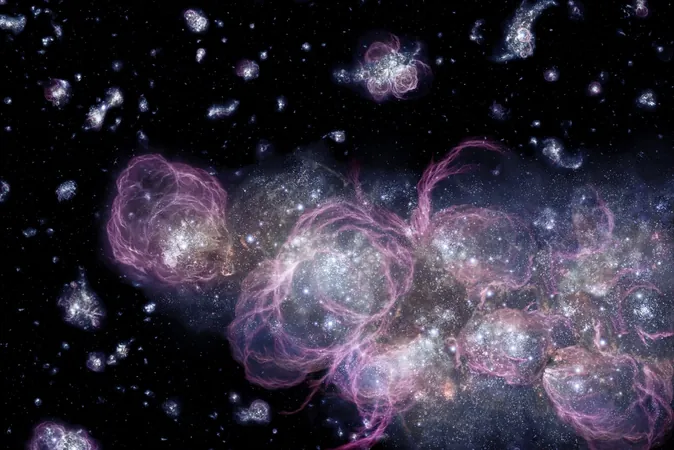
The Moment the Universe Was Born Anew: Unlocking the Secrets of Reionization
2025-01-02
Author: Wei
The Cosmic Dark Ages
For eons, following the Big Bang that birthed our universe, cosmic history laid dormant in an unremarkable haze. As the primordial soup of particles began to cool, the universe was enveloped in a shroud of neutral hydrogen gas, devoid of light, stars, galaxies, or planets. This monotonous realm, spanning millions of years, was known as the 'dark ages' of the universe.
The Epoch of Reionization
However, around 100 million years post-Big Bang, everything changed dramatically. This significant transition is recognized as the epoch of reionization, a period during which the first stars ignited and began transforming the universe. These early stars not only emitted dazzling light but were pivotal in changing the state of hydrogen that filled the universe. The intense radiation from these stars stripped electrons from hydrogen atoms, leading to a mix of ionized and neutral gas that characterizes our universe today.
The Last Major Shift
Renowned theoretical astrophysicist Julian Muñoz from the University of Texas at Austin states, 'It’s the last major shift that happens to our universe.' This transformation over the course of a billion years paved the way for the universe we observe today. Yet, despite our understanding of the epoch of reionization, significant mysteries still linger. Scientists grapple with questions about the timing of the first stars' formation, the types of galaxies involved, the influence of black holes, and how this grand transformation unfolded across space and time.
Technological Advancements
Exciting advancements in technology, particularly with the advent of the James Webb Space Telescope (JWST), have enabled scientists to peer deeper into the universe's early years. Launched in 2021, JWST has identified galaxies that existed a mere 350 million years after the Big Bang, surprising researchers with their abundance and maturity. These galaxies are far more massive and luminous than long assumed, challenging existing theories about the pace of stellar formation during this time and hinting at a more tumultuous, vibrant universe than previously imagined.
Unraveling Reionization
Further analysis revealed that the light produced by these early galaxies was more than sufficient to induce reionization, raising questions about its timing and mechanisms. The findings from JWST suggest that supermassive black holes may have emerged much earlier in the cosmic timeline than anticipated, emitting high-energy radiation that also contributed to the reionization process.
Next-Generation Telescopes
Scientists are also employing next-generation radio telescopes, such as the Hydrogen Epoch of Reionization Array (HERA), to study neutral hydrogen directly. The goal is to detect the elusive 21 cm signal that could unravel more about the distribution and fluctuations of hydrogen gas during this transitional epoch. This radio signal acts as a kind of cosmic thermometer, providing insight into the thermal history of the universe and potentially revealing exotic interactions involving dark matter.
Controversies and Future Prospects
Notably, past claims of observing the 21 cm signal from the early universe, such as the one made by the EDGES project, sparked substantial debate. They suggested colder-than-expected hydrogen gas, which some theorists attribute to unknown physics or novel interactions between hydrogen and dark matter.
Looking Ahead
As excitement builds in the astronomy community, future telescopes—potentially positioned on the Moon or in space—are expected to probe even deeper, free from Earth’s atmospheric interference. This intensive scrutiny promises to reshape our understanding of cosmic history and the emergence of complexity in the universe.
The Quest for Knowledge
While unanswered questions remain, scientists like Muñoz are optimistic. 'We’re knocking at the door,' he asserts, fueling the quest for knowledge about the universe's formative years. The implications of discovering the early universe's mysteries could fundamentally alter our view, providing crucial links to understanding dark matter, galaxy formation, and the evolution of the cosmos itself. Are we on the brink of uncovering the universe's oldest secrets? The answer lies just beyond the horizon of our current understanding, waiting to be explored.

 Brasil (PT)
Brasil (PT)
 Canada (EN)
Canada (EN)
 Chile (ES)
Chile (ES)
 Česko (CS)
Česko (CS)
 대한민국 (KO)
대한민국 (KO)
 España (ES)
España (ES)
 France (FR)
France (FR)
 Hong Kong (EN)
Hong Kong (EN)
 Italia (IT)
Italia (IT)
 日本 (JA)
日本 (JA)
 Magyarország (HU)
Magyarország (HU)
 Norge (NO)
Norge (NO)
 Polska (PL)
Polska (PL)
 Schweiz (DE)
Schweiz (DE)
 Singapore (EN)
Singapore (EN)
 Sverige (SV)
Sverige (SV)
 Suomi (FI)
Suomi (FI)
 Türkiye (TR)
Türkiye (TR)
 الإمارات العربية المتحدة (AR)
الإمارات العربية المتحدة (AR)